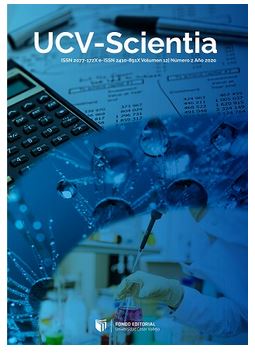Social Conflict in Electoral Times, Perú 2021
DOI:
https://doi.org/10.18050/RevUcv-Scientia.v14n1a1Keywords:
social problems; electoral campaign; electorate; public politicsAbstract
This work analyzes the electoral situation and the political, economic, social and health turbulence that Peru is going through in 2021 aggravated by the pandemic, it focuses on assessing the perception of voters regarding the management of governments in recent years, of the performance of political parties and electoral campaigns. The methodology used is quantitative research, non-experimental design and cross-sectional, collecting data through a questionnaire of 20 questions applied to a sample of 395 individuals between 18 to 65 years of age who live / settled in Peru in recent years. The results obtained in a general assessment of the categories are: 49.6% of the participants perceive poor management in the management of social problems in the last 10 years; 68.9% have a bad perception of the management of electoral campaigns and 79.0% perceive that political parties are regularly structured and organized. The conclusions determine a great dissatisfaction of the voters on the governmental management of the social problems, the bad perception in front of the polarization of the candidates and voters in full campaign, and the little representation / loyalty towards the semi-structured political parties.
References
Abbe, O. G., Goodliffe, J., Herrnson, P. S., & Patterson, K. D. (2003). Agenda Setting in Congressional Elections: The Impact of Issues and Campaigns on Voting Behavior. Political Research Quarterly, 56(4), 419–430. https://doi.org/10.1177/106591290305600404
Barrenechea, R., & Sosa, P. (2014). Perú 2013: La Paradoja de la Estabilidad. Revista de Ciencia Política, 267–292. https://doi.org/http://dx.doi.org/10.4067/S0718-090X2014000100013
Batone, D. C. (2020). Mercado de trabalho em contexto de pobreza urbana: o caso da cidade de Lichinga, Moçambique.Labor market in the context of urban poverty: the case of the city of Lichinga, MoçambiqueMercado laboral en el contexto de la pobreza urbana: el caso de la ciudad. Espaço e Economia, 19. https://doi.org/10.4000/espacoeconomia.17258
Benoit, W. L. (2000). A functional analysis of political advertising across media, 1998. Communication Studies, 51(3), 274–295. https://doi.org/10.1080/10510970009388524
Boggess, L. N., & Hipp, J. R. (2014). The Spatial Dimensions of Gentrification and the Consequences for Neighborhood Crime. Justice Quarterly, 33(4), 584–613. https://doi.org/10.1080/07418825.2014.943799
Cárdenas, A., Ballesteros, C., & Jara, R. (2017). Redes sociales y campañas electorales en Iberoamérica. Un análisis comparativo de los casos de España, México y Chile. Cuadernos.Info, 41, 19–40. https://doi.org/10.7764/cdi.41.1259
Carlin, R. E., Singer, M. M., & Zechmeister, E. J. (2015). The Latin American voter : pursuing representation and accountability in challenging contexts. The Unersity of Michigan Press. https://doi.org/https://doi.org/10.3998/mpub.8402589
Carvalho, A. R. de, & Sousa, L. R. de. (2021). A evolução conceitual da desigualdade e da pobreza no pensamento econômico. Brazilian Journal of Political Economy, 41(2), 402–425. https://doi.org/10.1590/0101-31572021-3142
Dalton, R. J. (2011). Left-Right Orientations, Context, and Voting Choices. Citizens, Context, and Choice: How Context Shapes Citizens’ Electoral Choices. https://doi.org/10.1093/ACPROF:OSO/9780199599233.003.0005
Gaitán-Rossi, P., & Velázquez Guadarrama, C. (2021). Revisión sistemática de la literatura sobre mecanismos que vinculan crimen y pobreza. Convergencia Revista de Ciencias Sociales, 28, 1. https://doi.org/10.29101/crcs.v28i0.14685
Griffiths, E., & Tita, G. (2009). Homicide in and around public housing: Is public housing a hotbed, a magnet, or a generator of violence for the surrounding community? Social Problems, 56(3), 474–493. https://doi.org/10.1525/sp.2009.56.3.474
Hernández Sampieri, R., Fernández Collado, C., & Baptista Lucio, P. (2014). Metodología de la Investigación (Mc Graw Hill (ed.); Sexta Edic). 2014. https://www.uca.ac.cr/wp-content/uploads/2017/10/Investigacion.pd
Kaid, L. L., & Holtz-Bacha, C. (2006). Television Advertising and Democratic Systems Around the World. The SAGE Handbook of Political Advertising, September 2003, 445–458. https://doi.org/10.4135/9781412973403.n27
Kitschelt, H., & Wilkinson, S. I. (2007). Citizen–politician linkages: An introduction. In H. Kitschelt & S. Wilkinson (Eds.), Patrons, Clients and Policies: Patterns of Democratic Accountability and Political Competition. Cambridge: Cambridge University Press, 1–49. https://doi.org/10.1017/CBO9780511585869.001
Lachat, R. (2008). The impact of party polarization on ideological voting. Electoral Studies, 27(4), 687–698. https://doi.org/10.1016/j.electstud.2008.06.002
Larreguy, H. A., Marshall, J., & Snyder, J. M. (2018). Leveling the playing field: How campaign advertising can help non-dominant parties. Journal of the European Economic Association, 16(6), 1812–1849. https://doi.org/10.1093/jeea/jvy001
López-López, P.-C., & Oñate, P. (2019). De la videopolítica a la ciberpolítica: debate entre candidatos y televisiones en cinco elecciones presidenciales. El Profesional de La Información, 28(5), 1–13. https://doi.org/10.3145/epi.2019.sep.12
Meléndez, C., & Vergara, A. (2010). La Iniciación de la Política. In Pontificia Universidad Católica del Perú.
Paris, E. (2018). Penser la communication (Dominique Wolton). Réseaux, 15(84), 166–168. http://www.persee.fr/web/revues/home/prescript/article/reso_0751-7971_1997_num_15_84_3099
Ridout, T. N., Franz, M. M., & Fowler, E. F. (2015). Sponsorship, Disclosure, and Donors: Limiting the Impact of Outside Group Ads. Political Research Quarterly, 68(1), 154–166. https://doi.org/10.1177/1065912914563545
Sniderman, P. M., & Levendusky, M. S. (2009). An Institutional Theory of Political Choice. The Oxford Handbook of Political Behavior, June, 1–23. https://doi.org/10.1093/oxfordhb/9780199270125.003.0023
Sulmont, D. (2018). ¿Existe el voto programático en elecciones con un sistema de partidos políticos débil? Un análisis de las elecciones presidenciales peruanas de 2016. Revista de Ciencia Política (Santiago), 38(3), 429–457. https://doi.org/10.4067/s0718-090x2018000300429
Tanaka, M. (2005). Democracia sin partidos Perú, 2000-2005 (Colección). Instituto de Estudios Peruanos.
Van Steenburg, E. (2015). Areas of research in political advertising: A review and research agenda. International Journal of Advertising, 34(2), 195–231. https://doi.org/10.1080/02650487.2014.996194
Downloads
Published
How to Cite
Issue
Section
License

This work is licensed under a Creative Commons Attribution-NonCommercial 4.0 International License.
- Share — copy and redistribute the material in any medium or format
- Adapt — remix, transform, and build upon the material.
- The licensor cannot revoke these freedoms as long as you follow the license terms.
Under the following terms:
-
Attribution — You must give appropriate credit, provide a link to the license, and indicate if changes were made. You may do so in any reasonable manner, but not in any way that suggests the licensor endorses you or your use.
- No additional restrictions — You may not apply legal terms or technological measures that legally restrict others from doing anything the license permits.













